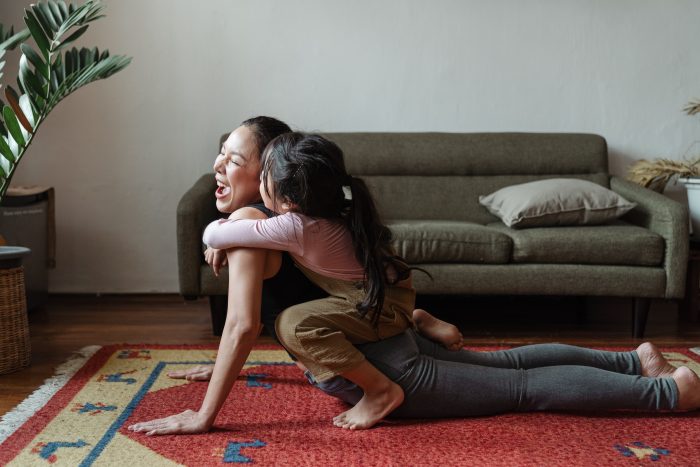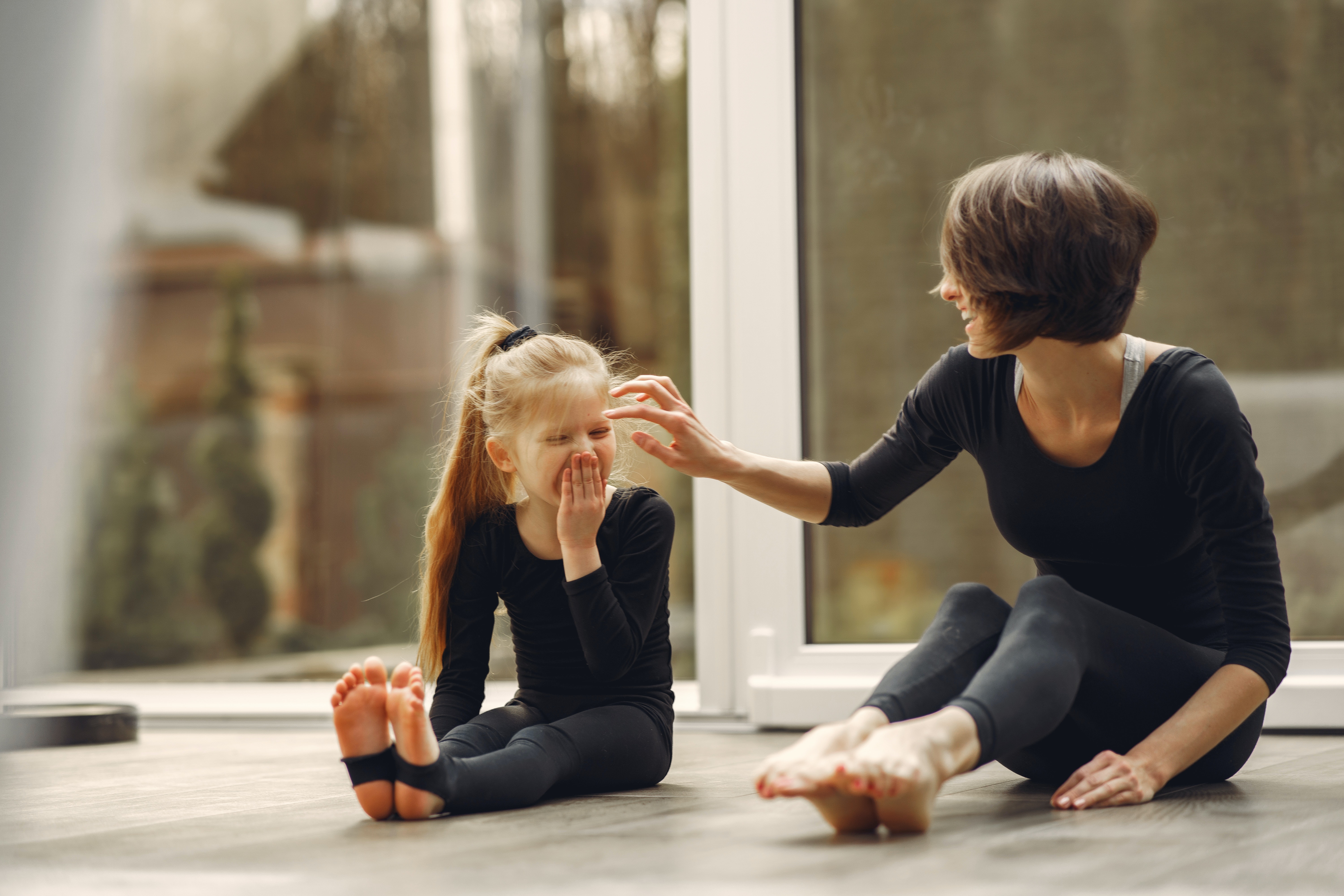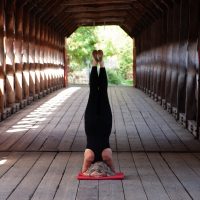When we think about children and their development, we must remember that children develop in their own time and way.
Certainly, there are norms, milestones, and typical stages that all children go through, but everyone is unique.
No one person is going to reach a specific milestone or learn a specific skill at exactly the same time or in exactly the same way. Remembering this and acknowledging this is essential.
Celebrate individuality and creativity! Allow children freedom to express themselves in the way that suits them best. Strengthen their self-concept by honouring their unique and beautiful differences. The joy of yoga with children is…there is no wrong!
Yoga with young children is very much about using and creating games to teach postures, breathing, meditation techniques, and relaxation skills. Adapting well-known games with elements of yoga is easy and accessible. Building little bits of yoga throughout the day, week, and year with songs and fun rituals helps to instill a solid grounding in all aspects of yoga.
By connecting games and activities to yogic philosophy, children are able to experience the true power and magic of this ancient practice.
~
Best way to to keep your core pelvic and org@sm muscles strong and resilient? Here’s the coveted apparatus that makes this possible >>
~
Weaving elements of kindness, honesty, compassion, and self-control in and out of children’s daily experiences further supports them in their development and their lives.
Guiding Children’s Behaviour
Best practice in early childhood education tells us that a solid understanding of child development, trust with secure attachment, and consistent routines and reliable schedules are all key factors for quality early learning.
In order to effectively and successfully guide children’s behaviour and support learning, children must be allowed to experience success and feel competent. They must feel safe and cared for by the significant adults in their lives.
When these pieces are in place, children thrive, feel joyful, and experience happiness. Skilled and loving educators—who carefully plan schedules and routines—are key ingredients to making this happen. Educators should plan for and schedule yoga games and activities regularly and consistently to make them part of children’s everyday lives.
Designing a Basic Program
Sequencing and timing are important aspects to be considered when designing a yoga class. Understanding and meeting the children at their developmental level is essential. Keeping it fun, non-competitive, and creative are excellent elements to integrate into any practice.
Most yoga poses were originally named after things found in the natural world. In children’s yoga, the use of animals, plants, and other well-known objects help to make the poses more relatable and can be imagined easily by the children.
Focus on having fun with movement, not on practicing perfectly aligned poses. Follow the interests of the children. Cater to their energy levels and different learning styles. Adjust the number of poses depending on the ages and needs of the children.
Class Length: Keep it short and keep it fun!
Preschoolers should not be expected to manage anything longer than 10 to 15 minutes of instructional yoga. Over time and with consistent daily practice this time may be extended slightly. School-age children would be able to manage 15 to 30 minutes classes that are fun and include a lot of freedom to move. Over time and with consistent daily practice, this time may be extended to 45 minutes.
Physical Space: Use what you have.
Yoga can be done anywhere and everywhere. Yoga is lovely outside on the grass, in childcare playrooms, in elementary classrooms, in libraries, and of course in gyms, multipurpose rooms, or designated studios. Any space where you and the children can sit, stand, and move about will do.
It is helpful to try to find a space where distractions can be kept to a minimum and where the temperature is warm and comfortable. Whenever possible and appropriate, gather the children into a circle. Circles are naturally inclusive, encourage equality, and allow everyone a good view. Natural light is best and keeping florescent lighting to a minimum is recommended.
Equipment: You don’t need anything special.
Ideally there should be enough yoga mats for each child. Adult yoga mats may be cut in half for preschool children. If mats are not available, then a beach towel works perfectly.
The mat or towel allows each child to have their own designated space and creates a sense of boundary and safety. Children should be taught that each person’s mat is their own “personal” space and others are not to interfere with that. Stepping on another person’s mat is considered impolite or disrespectful and should be discouraged. Props and accessories can be introduced into the yoga experience but are not necessary.
Movement and Body Awareness: All about asana.
Much of yoga is about developing a greater connection and awareness to the physical and emotional body. As a non-competitive practice, yoga is especially beneficial for children. It helps them to connect to and align with themselves.
Through this practice, children develop a connection and understanding of where their body is in space, known as proprioception, and how their body feels on the inside, known as interoception. These terms are sometimes referred to as the sixth and seventh sense, and both are developed, supported, and strengthened through yoga.
Proprioception is the term used to describe the feeling of knowing where your body is in space. Dancers and elite athletes have a highly developed sense of proprioception. They understand, feel, and know how to move their body with careful precision. By increasing and supporting proprioception through the physical practice (asana) of yoga, children are able to develop strength and stability, improve co-ordination, and feel a heightened connectedness and competence with their physical bodies.
Interoception is a lesser-known sense that helps a person understand and feel what’s going on inside their body. Children who struggle with the interoceptive sense may have trouble knowing when they feel hungry, full, hot, cold, or thirsty. Having trouble with this sense can also make self-regulation a challenge.
Yoga trains the body and the mind to tune in, focus, and feel. It is what is often thought of as the mind-body connection. Through this process children can learn to recognize internal sensations, feelings, and emotions. As children develop this deeper connection to how they feel, they are able to identify, recognize, and connect to their own distinctiveness and strengthen their sense of self. This greater awareness also helps children to express themselves and develop the capacity to understand the feelings of others.
“Body awareness is crucial to the development of a child’s image of ‘self.’ A child who knows how his body works is more likely to participate in physical activities, exercises, and games, and to have a general sense of well-being.” ~ “Moving and Growing,” Canadian Institute of Child Health
Tuning into the Breath: All about pranayama.
Conscious breath is foundational to yoga. Observing and using the breath with awareness is one of the most powerful tools in our yoga practice. Breath is life sustaining. Without breath we cannot live. And yet, despite the significance of the breath, it is typically an unconscious function. We don’t think about breathing as we go about our daily lives; we simply breathe.
Effective use of breath awareness is directly connected to the central nervous system. The sympathetic and parasympathetic nervous systems are directly affected by our breath. The sympathetic nervous system governs what is referred to as “fight-or-flight” or “fight or freeze” mode. Rapid, shallow breathing taken in and out through the mouth occurs when the sympathetic nervous system is activated. When this system is activated, the brain tells the body there is some kind of threat and therefore more oxygen is required. This is an important survival response necessary when a real threat to safety is present.
Unfortunately, many people use shallow mouth breathing even when no threat is present.
Many children experience chronic low levels of stress and anxiety in their daily lives. The source of this stress and anxiety may be unknown or not obvious and can have immediate and long-term implications on health and development. Young children have sensitive nervous systems which become overstimulated easily.
Overstimulation from the environment is often problematic. Bright lights and excessive noise are common causes of stress in children, as is chaotic and unpredictable schedules. When the body is operating in this heightened state of arousal, the immune system may become compromised, decision-making may be impacted and impulsive, and defensive and negative responses to situations frequently result.
Overstimulation in children often looks like aggression, tantrums, and emotional meltdowns. Teaching focused, slow, deep breathing (pranayama) is a powerful technique for helping children to cope and feel better. Research has documented the benefits of a regular practice of simple, deep breathing, suggesting it helps to reduce anxiety, encourage muscle relaxation, and decrease feelings of stress and overwhelm.
“Breathe in deeply to bring your mind home to your body.” ~ Thich Nhat Hanh
Teaching children specific breathing techniques to help them feel their bodies, understand sensations, and regulate emotions are powerful life skills. Breathing techniques can be practiced seated, standing, or lying down. Remind children that some techniques may be difficult to learn and reassure them that with practice they will soon learn how to do it.
Bubble Breathing: Simple and fun.
“Sit comfortably with your eyes closed. Begin by imagining you are holding a bubble wand. Breathe in deeply and then, as you breathe out slowly and gently, imagine you are blowing bubbles into the room. Imagine the bubbles are filled with peace or love or happiness and that you are filling the whole room with a peaceful, happy feeling. As you keep breathing slowly and blowing your imaginary bubbles, feel your body become calm and relaxed.”
Holding Space: Role of the Educator
Creating a loving environment for the children in our care is both an honour and a privilege. Watching, supporting, and guiding children as they grow and learn is also an immense responsibility.
Through professional training and intentional practice, the experiences we provide for children feed their minds, hearts, and bodies. Creating a sense of inclusion, respect, and friendliness cultivates and develops healthy social and emotional development.
And through the practice of yoga, educators can create spaces where children, all children, feel competent, safe, and welcome. It is with great care and thoughtful intention that safe spaces emerge. It is from an accepting and open heart that educators are able to hold these safe spaces and welcome the children in.
Learning is a two-way street. Educators are also students—lifelong learning is a necessary part of teaching yoga to children. As educators, we are continuously learning and evolving. Remembering that each of us, big and small, are unique and bring something special to this world.
Each child has lessons to teach us if we are open to learning them. Through careful listening, thoughtful observation, and with an open heart, we can be both the student and the teacher. With a fair dose of curiosity, a little bit of carefree abandon, plenty of laughter, and an equal amount of trust, the joyful lessons of childhood will bring greater happiness into our hearts and into our lives.
Yogic Philosophy in Early Childhood: What does that look like?
Yoga is a rich and multilayered discipline seeped in centuries of philosophy and scholarly study. Having some basic knowledge of the philosophical and ethical elements of yoga is helpful when trying to share this practice with young children.
Through the use of plain language and modern sensibilities, yogic teachings can be uncovered, and the underlying essence of yoga will emerge. Simple and relatable concepts, key themes, and foundational yogic knowledge help to unpack these concepts allowing them to become useful for modern practice and everyday life.
Teaching the Yamas: Guiding principles to be considered when sharing yoga with children.
Ahimsa: Love and compassion for all, peacefulness
Children should be invited but never forced to practice yoga. Participation should always be optional. Educators should pay close attention to the children, observing how they are experiencing and reacting to the practice. Children should be allowed to opt out and simply observe if that is their preference.
Satya: Truthfulness and integrity
Your attitude changes everything. Approach yoga as a fun, playful experience. Remember that this practice is ultimately a personal inquiry into the self. Use gentle words and model how you would like them to move or engage.
Astheya: Honesty, generosity
Allow the children freedom to move and breathe in ways that feel right for their bodies. There is no wrong way to feel, so as long as the movement is safe. Resist the temptation to correct them.
Bramacharya: Balance, moderation, self-control
If something doesn’t feel right, stop. Yoga is all about tuning in and feeling, so remember to take time to do just that. Encourage and support the children in practicing moderation and balance while encouraging awareness toward self-control. Support non-competitive experiences.
Aparigraha: Awareness of abundance, appreciation
Take your time. Remember there is no rush to get anywhere. Yoga is often referred to as a “path” toward a more joyful life, so enjoy the journey. Enjoy the present and practice gratitude for today’s joyful moments.
Teaching the Niyamas: Supporting a way of being
Saucha: Simplicity, purity
Keep things simple and introduce new concepts and practices little by little over time.
Santosha: Contentment
Cultivate an atmosphere of calm. Encourage and support children as they practice and experience yoga for themselves. Acknowledge and remind the children that they know best how they “feel” in their bodies and they have the right to “feel” exactly how they “feel.” (Sometimes that may not look like contentment, but over time and with practice it will come.)
Tapas: Zeal and sincerity, right action
Celebrate and share in the joy of others. Recognize, acknowledge, and encourage respect for differences and the uniqueness of each person.
Swadyaya: Study, introspection, self-reflection
Invite time for quiet. Create opportunities for personal time and encourage creative self-expression.
Iswara Pranidhana: Wholehearted dedication, devotion
Intentionally invite peace into your life and the life of others. Build a variety of yoga practices into children’s daily life through creative movement, conscious breath, sense (emotional) awareness, kind words, and a compassionate heart.
Routines & Transitions
In childcare, kindergarten, and other early learning settings, educators and children have to negotiate many routines and transitions daily. These are busy and often hectic times. When routines and transitions are thoughtfully planned and intentionally executed, chaos can be averted.
Developing daily rituals associated with specific routines and transitions makes them pleasant and encourages cooperation. Build little bits of yoga right into every aspect of the day and help children experience less hustle and bustle.
Ideas for building yoga into the day may include:
Gratitude Practice: at arrival, during group time, or at snack have children state one thing they are grateful for (or what makes them happy). Write it down on a Post-it note and pop it in a jar or stick it on the wall. Enjoy reading them back to the children at some designated time later that week. Repeat this often. Make it a ritual!
Mantra and Mudra Practice: when waiting in line, for the bathroom, or for lunch to be served, teach the children simple hand mudras and sing simple mantras. A simple and lovely mantra meditation is “Sa ta na ma.” While saying each of these sounds, touch the thumb to a finger, beginning with the index finger. This is a circle of life meditation. (Sa is birth, ta is life, na is death, and ma is rebirth.)
Flowing Asana: when moving the group from room to room or going outside, invite the children to move in shapes like the poses they have learned: walking like a candle with hands overhead, Warrior II stepping with arms stretched, or hopping like a frog. Make it fun!
Say it with Puppets: introduce a “special” puppet as the yoga leader of a fun yoga game or class from time to time. Don’t overuse the puppet to keep its “specialness.” Invite the special yoga leader puppet to guide the children through various transitions. Stop every few moments to “strike a pose.” The puppet can call out different yoga poses for the children to do.
Meditation Space: build a little corner in the playroom that is a designated quiet, calm space. Incorporate as much privacy as possible; using sheer curtains works well. Be sure children are clear on the rules associated with this space. Make it a “sacred” space for quiet contemplation only. Decorate with electric tealights, mala beads for concentrating, a basket of gemstone pebbles, pinwheels and/or feathers for focused breathwork, shawls for warmth, and meditation cushions for sitting. Have a deck of breathing cards available to remind the children of ways to practice pranayama. Post a few pictures of natural beauty that evoke calm—sunrise photos work well. Teach the children a few simple meditations so they can use them on their own.
Play, Play, Play!
It is all about play! Having fun and making it fun is the direct route to learning for children (and adults).
Keeping this principle firmly in mind with respect to yogic teaching is paramount. Tuning into particular interests and incorporating them into your yoga and other daily activities will encourage enthusiasm and cooperation. Never make yoga mandatory. Participation should always be optional, but if it is fun, children will want to join in.

 Share on bsky
Share on bsky








Read 1 comment and reply